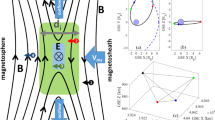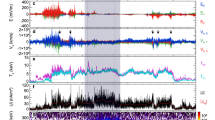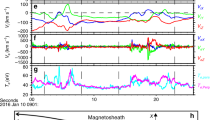Abstract
Magnetic reconnection in current sheets is a magnetic-to-particle energy conversion process that is fundamental to many space and laboratory plasma systems. In the standard model of reconnection, this process occurs in a minuscule electron-scale diffusion region1,2. On larger scales, ions couple to the newly reconnected magnetic-field lines and are ejected away from the diffusion region in the form of bi-directional ion jets at the ion Alfvén speed3,4,5. Much of the energy conversion occurs in spatially extended ion exhausts downstream of the diffusion region6. In turbulent plasmas, which contain a large number of small-scale current sheets, reconnection has long been suggested to have a major role in the dissipation of turbulent energy at kinetic scales7,8,9,10,11. However, evidence for reconnection plasma jetting in small-scale turbulent plasmas has so far been lacking. Here we report observations made in Earth’s turbulent magnetosheath region (downstream of the bow shock) of an electron-scale current sheet in which diverging bi-directional super-ion-Alfvénic electron jets, parallel electric fields and enhanced magnetic-to-particle energy conversion were detected. Contrary to the standard model of reconnection, the thin reconnecting current sheet was not embedded in a wider ion-scale current layer and no ion jets were detected. Observations of this and other similar, but unidirectional, electron jet events without signatures of ion reconnection reveal a form of reconnection that can drive turbulent energy transfer and dissipation in electron-scale current sheets without ion coupling.
This is a preview of subscription content, access via your institution
Access options
Access Nature and 54 other Nature Portfolio journals
Get Nature+, our best-value online-access subscription
$29.99 / 30 days
cancel any time
Subscribe to this journal
Receive 51 print issues and online access
$199.00 per year
only $3.90 per issue
Buy this article
- Purchase on Springer Link
- Instant access to full article PDF
Prices may be subject to local taxes which are calculated during checkout



Similar content being viewed by others
Change history
10 May 2019
Change history: In this Letter, the y-axis values in Fig. 3f should go from 4 to −8 (rather than from 4 to −4), the y-axis values in Fig. 3h should appear next to the major tick marks (rather than the minor ticks), and in Fig. 1b, the arrows at the top and bottom of the electron-scale current sheet were going in the wrong direction; these errors have been corrected online.
References
Vasyliunas, V. M. Theoretical models of magnetic merging. Rev. Geophys. 13, 303–336 (1975).
Burch, J. L. et al. Electron-scale measurements of magnetic reconnection in space. Science 352, aaf2939 (2016).
Paschmann, G. et al. Plasma acceleration at the Earth’s magnetopause: evidence for reconnection. Nature 282, 243–246 (1979).
Phan, T. D. et al. Extended magnetic reconnection at the Earth’s magnetopause from detection of bi-directional jets. Nature 404, 848–850 (2000).
Gosling, J. T., Skoug, R. M., McComas, D. J. & Smith, C. W. Direct evidence for magnetic reconnection in the solar wind near 1 AU. J. Geophys. Res. 110, A01107 (2005).
Petschek, H. E. Magnetic field annihilation. In Proc. AAS-NASA Symposium on the Physics of Solar Flares (ed. Hess, W. N.) 425–439 (NASA, 1964)
Matthaeus, W. H. & Lamkin, S. L. Turbulent magnetic reconnection. Phys. Fluids 29, 2513–2534 (1986).
Servidio, S., Matthaeus, W. H., Shay, M. A., Cassak, P. A. & Dmitruk, P. Magnetic reconnection in two-dimensional magnetohydrodynamic turbulence. Phys. Rev. Lett. 102, 115003 (2009).
Retinò, A. et al. In situ evidence of magnetic reconnection in turbulent plasma. Nat. Phys. 3, 235–238 (2007).
Sundqvist, D., Retinò, A., Vaivads, A. & Bale, S. D. Dissipation in turbulent plasma due to reconnection in thin current sheets. Phys. Rev. Lett. 99, 025004 (2007).
Haggerty, C. C. et al. Exploring the statistics of magnetic reconnection X-points in kinetic particle-in-cell turbulence. Phys. Plasmas 24, 102308 (2017).
Chasapis, A. et al. Electron heating at kinetic scales in magnetosheath turbulence. Astrophys. J. 836, 247 (2017).
Rager, A. C. et al. Electron crescent distributions as a manifestation of diamagnetic drift in an electron scale current sheet: magnetospheric multiscale observations using new 7.5 ms fast plasma investigation moments. Geophys. Res. Lett. 45, 578–584 (2018).
Eriksson, E. et al. Strong current sheet at a magnetosheath jet: kinetic structure and electron acceleration. J. Geophys. Res. 121, 9608–9618 (2016).
Yordanova, E. et al. Electron scale structures and magnetic reconnection signatures in the turbulent magnetosheath. Geophys. Res. Lett. 43, 5969–5978 (2016).
Vörös, Z. et al. MMS observations of magnetic reconnection in the turbulent magnetosheath. J. Geophys. Res. 122, 11442–11467 (2017).
Chen, L. J. et al. Electron energization and mixing observed by MMS in the vicinity of an electron diffusion region during magnetopause reconnection. Geophys. Res. Lett. 43, 6036–6043 (2016).
Phan, T. D., Drake, J. F., Shay, M. A., Mozer, F. S. & Eastwood, J. P. Evidence for an elongated (60 ion skin depths) electron diffusion region during fast magnetic reconnection. Phys. Rev. Lett. 99, 255002 (2007).
Wilder, F. D. et al. Multipoint measurements of the electron jet of symmetric magnetic reconnection with a moderate guide field. Phys. Res. Lett. 118, 265101 (2017).
Burch, J. L. & Phan, T. D. Magnetic reconnection at the dayside magnetopause: advances with MMS. Geophys. Res. Lett. 43, 8327–8338 (2016).
Pritchett, P. L. Geospace environment modeling magnetic reconnection challenge: simulations with a full particle electromagnetic code. J. Geophys. Res. 106, 3783–3798 (2001).
Shay, M. A. et al. Structure of the dissipation region during collisionless magnetic reconnection. J. Geophys. Res. 103, 9165–9176 (1998).
Zenitani, S., Hesse, M., Klimas, A. & Kuznetsova, M. New measure of the dissipation region in collisionless magnetic reconnection. Phys. Rev. Lett. 106, 195003 (2011).
Shay, M. A. et al. Electron heating during magnetic reconnection: a simulation scaling study. Phys. Plasmas 21, 122902 (2014).
Mandt, M. E. et al. Transition to whistler mediated magnetic reconnection. Geophys. Res. Lett. 21, 73–76 (1994).
Meyer, J. C. Structure of the Diffusion Region in Three Dimensional Magnetic Reconnection. PhD thesis, Univ. Delaware (2015).
He, J. S. et al. Two-dimensional correlation functions for density and magnetic field fluctuations in magnetosheath turbulence measured by the Cluster spacecraft. J. Geophys. Res. 116, A06207 (2011).
Torbert, R. B. et al. The FIELDS instrument suite on MMS: scientific objectives, measurements, and data products. Space Sci. Rev. 199, 105–135 (2016).
Gosling, J. T. & Phan, T. D. Magnetic reconnection in the solar wind at current sheets associated with extremely small field shear angles. Astrophys. J. 763, L39 (2013).
Sonnerup, B. U. Ö. & Cahill, L. J. Jr. Magnetopause structure and attitude from Explorer 12 observations. J. Geophys. Res. 72, 171–183 (1967).
Acknowledgements
We are grateful for the dedicated efforts of the MMS team. We thank J. Gosling, who inspired us to search for unconventional reconnection in space. This work was supported by NASA contract number NNG04EB99C at SwRI, which funded work at most of the co-authors’ institutions in the United States. The work at U. C. Berkeley was supported by NASA grants 80NSSC18K0157 and NNX08AO83G. UK involvement at Imperial College was supported by STFC (UK) grant ST/N000692/1. The French involvement (SCM instruments) on MMS is supported by CNES, CNRS-INSIS and CNRS-INSU.
Reviewer information
Nature thanks G. Paschmann and the other anonymous reviewer(s) for their contribution to the peer review of this work.
Author information
Authors and Affiliations
Contributions
T.D.P. carried out the data analysis, interpretation and manuscript preparation. J.P.E., M.A.S., J.F.D., B.U.Ö.S., M.F., P.A.C., M.Ø., P.S.P., C.C.H., M.O., and A.R. contributed to the data interpretation and manuscript preparation. J.L.B. led the successful design and operation of the MMS mission and contributed to the interpretation of the data. A.C.R., J.C.D., D.J.G., C.P., B.L., B.L.G., T.E.M., and Y.S. contributed to the development and operation of and the interpretation of data from the Fast Plasma instruments. R.B.T., R.E.E., Y.K., M.R.A., F.D.W. and P.A.L. contributed to the development and operation of and the interpretation of data from the electric-field experiments. O.L.C. contributed to the development and operation of the search-coil magnetometers. C.T.R., R.J.S., and W.M. contributed to the development and operation of the fluxgate magnetometers.
Corresponding author
Ethics declarations
Competing interests
The authors declare no competing interests.
Additional information
Publisher’s note: Springer Nature remains neutral with regard tojurisdictional claims in published maps and institutional affiliations.
Extended data figures and tables
Extended Data Fig. 1 Large-scale context of the thin current sheet, illustrating the fact that the electron-scale current sheet was a stand-alone current sheet, not embedded inside an ion-scale one.
Data are shown in the LMN coordinates determined for the thin current sheet and used in Fig. 3. a, Magnetic field. b, Ion velocity. c, Electron velocity. d, j · (E + Ve × B) = j · E′. The thin reconnecting current sheet stands out in this interval, with nothing else approaching its current density or its value of j · (E + Ve × B). The absence of an ion-scale current sheet enveloping the electron-scale current sheet is indicated by the fact that |BL| reaches essentially its asymptotic values immediately outside the thin current sheet.
Extended Data Fig. 2 Absence of reconnection ion jetting.
The data are in GSE coordinates. a, Magnetic field. b, Ion velocity. c, d, y (c) and z (d) components of the ion velocity (Vi) and Alfvén velocity (VA). VA is relative to the reference velocity, density and magnetic-field values at the left edge of the data interval: VA = Bref(1−αref)1/2(μ0ρref)−1/2−B(1−α)1/2(μ0ρ)−1/2, where μ0 is the vacuum permeability, α = (p||−p⊥)μ0/B2 is the pressure anisotropy factor and ρ is the mass density of the plasma3. The expected speeds of the ion reconnection jets embedded inside many of the large-magnetic-shear current sheets are in the range of 100–200 km s−1, based on BL variations of around 20−40 nT (a). If present, such jets are readily recognized by back-to-back opposite correlations between ion velocity and magnetic-field variation at the two edges of the current sheet, which indicate pairs of rotational discontinuities emanating from the X-line5. These signatures are not seen here. What we instead find in the data is either no correlation between components of Vi and B, or a single correlation (or anti-correlation), indicative of Alfvénic structures16 rather than reconnection jetting.
Extended Data Fig. 3 Four-spacecraft observations of the reconnecting current sheet.
A common current-sheet LMN coordinate system (same as in Fig. 3) was used for consistency, justified by the fact that the LMN coordinates at individual spacecraft differ from each other by less than 4°. a–d, L (a, c) and M (b, d) components of the magnetic field (a, b) and of the electron velocity (c, d). e, M component of the current density. f, L component of the E × B/B2 velocity. g, N component of the electric field. h, Electric-field component parallel to the magnetic field. i, j · (E + Ve × B) = j · E′. j, Spacecraft locations relative to MMS 1, in kilometres (roughly de). The BL profiles (a) show that MMS 1 and MMS 3 crossed the current sheet at essentially the same time, preceded by MMS 4 and followed by MMS 2. The fact that MMS 4 exited the current sheet before MMS 2 entered it places an upper limit on the thickness of the current sheet, which is the 4.5-km separation distance between the two spacecraft along N (j). This is consistent with the current-sheet width of 4 km determined from the motion and crossing duration of the current sheet. Inside the current sheet, MMS 4 detected a positive (E × B/B2)L (except at the right edge), similarly to MMS 3, whereas MMS 2 detected a negative (E × B/B2)L, similarly to MMS 1. This indicates that there was a pair of spacecraft on each side of the X-line. All four spacecraft detected a predominantly negative E||. The parameter j · (E + Ve × B) was consistently positive at all four spacecraft throughout the current sheet, with the amplitude being lowest at MMS 2. MMS 2 also detected the largest guide-field (BM) compression, fastest ΔVeL and (E × B/B2)L jets, slowest ΔVeM and weakest E||, which together may suggest that MMS 2 was furthest away from the X-line.
Rights and permissions
About this article
Cite this article
Phan, T.D., Eastwood, J.P., Shay, M.A. et al. Electron magnetic reconnection without ion coupling in Earth’s turbulent magnetosheath. Nature 557, 202–206 (2018). https://doi.org/10.1038/s41586-018-0091-5
Received:
Accepted:
Published:
Issue Date:
DOI: https://doi.org/10.1038/s41586-018-0091-5
This article is cited by
-
Magnetic reconnection in the magnetodisk of centrifugally dominated giant planets
Reviews of Modern Plasma Physics (2024)
-
Magnetic Reconnection at Planetary Bodies and Astrospheres
Space Science Reviews (2024)
-
Equilibrium selection via current sheet relaxation and guide field amplification
Nature Communications (2023)
-
Topology of turbulence within collisionless plasma reconnection
Scientific Reports (2023)
-
Recent progress on magnetic reconnection by in situ measurements
Reviews of Modern Plasma Physics (2023)
Comments
By submitting a comment you agree to abide by our Terms and Community Guidelines. If you find something abusive or that does not comply with our terms or guidelines please flag it as inappropriate.



